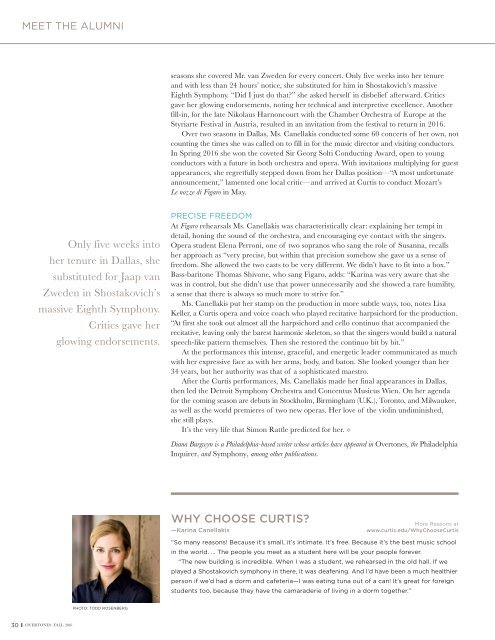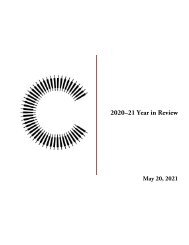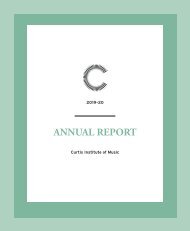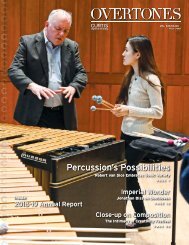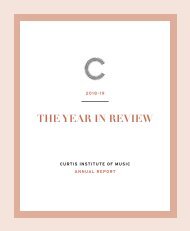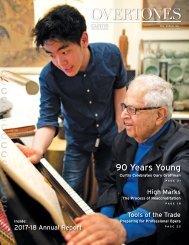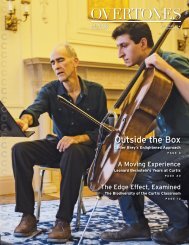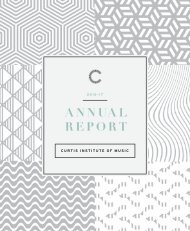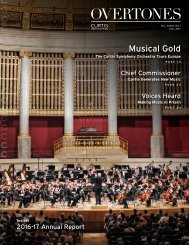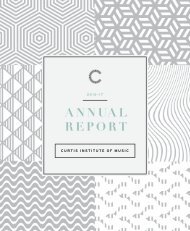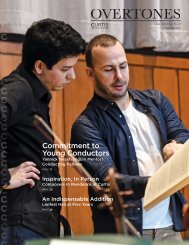Overtones: Fall 2016
Overtones is the semi-annual magazine of the Curtis Institute of Music. In this issue, we celebrate three decades of Mikael Eliasen's tenure, reveal the dynamic history of the Darmstadt school, and more.
Overtones is the semi-annual magazine of the Curtis Institute of Music. In this issue, we celebrate three decades of Mikael Eliasen's tenure, reveal the dynamic history of the Darmstadt school, and more.
Create successful ePaper yourself
Turn your PDF publications into a flip-book with our unique Google optimized e-Paper software.
MEET THE ALUMNI<br />
seasons she covered Mr. van Zweden for every concert. Only five weeks into her tenure<br />
and with less than 24 hours’ notice, she substituted for him in Shostakovich’s massive<br />
eighth Symphony. “Did I just do that?” she asked herself in disbelief afterward. Critics<br />
gave her glowing endorsements, noting her technical and interpretive excellence. another<br />
fill-in, for the late Nikolaus harnoncourt with the Chamber Orchestra of europe at the<br />
Styriarte Festival in austria, resulted in an invitation from the festival to return in <strong>2016</strong>.<br />
Over two seasons in Dallas, Ms. Canellakis conducted some 60 concerts of her own, not<br />
counting the times she was called on to fill in for the music director and visiting conductors.<br />
In Spring <strong>2016</strong> she won the coveted Sir Georg Solti Conducting award, open to young<br />
conductors with a future in both orchestra and opera. With invitations multiplying for guest<br />
appearances, she regretfully stepped down from her Dallas position—“a most unfortunate<br />
announcement,” lamented one local critic—and arrived at Curtis to conduct Mozart’s<br />
Le nozze di Figaro in May.<br />
Only five weeks into<br />
her tenure in Dallas, she<br />
substituted for Jaap van<br />
Zweden in Shostakovich’s<br />
massive eighth Symphony.<br />
Critics gave her<br />
glowing endorsements.<br />
PRECISE FREEDOM<br />
at Figaro rehearsals Ms. Canellakis was characteristically clear: explaining her tempi in<br />
detail, honing the sound of the orchestra, and encouraging eye contact with the singers.<br />
Opera student elena Perroni, one of two sopranos who sang the role of Susanna, recalls<br />
her approach as “very precise, but within that precision somehow she gave us a sense of<br />
freedom. She allowed the two casts to be very different. We didn’t have to fit into a box.”<br />
Bass-baritone thomas Shivone, who sang Figaro, adds: “Karina was very aware that she<br />
was in control, but she didn’t use that power unnecessarily and she showed a rare humility,<br />
a sense that there is always so much more to strive for.”<br />
Ms. Canellakis put her stamp on the production in more subtle ways, too, notes lisa<br />
Keller, a Curtis opera and voice coach who played recitative harpsichord for the production.<br />
“at first she took out almost all the harpsichord and cello continuo that accompanied the<br />
recitative, leaving only the barest harmonic skeleton, so that the singers would build a natural<br />
speech-like pattern themselves. then she restored the continuo bit by bit.”<br />
at the performances this intense, graceful, and energetic leader communicated as much<br />
with her expressive face as with her arms, body, and baton. She looked younger than her<br />
34 years, but her authority was that of a sophisticated maestro.<br />
after the Curtis performances, Ms. Canellakis made her final appearances in Dallas,<br />
then led the Detroit Symphony Orchestra and Concentus Musicus Wien. On her agenda<br />
for the coming season are debuts in Stockholm, Birmingham (U.K.), toronto, and Milwaukee,<br />
as well as the world premieres of two new operas. her love of the violin undiminished,<br />
she still plays.<br />
It’s the very life that Simon rattle predicted for her. <br />
Diana Burgwyn is a Philadelphia-based writer whose articles have appeared in <strong>Overtones</strong>, the Philadelphia<br />
Inquirer, and Symphony, among other publications.<br />
WHY CHOOSE CURTIS?<br />
—Karina Canellakis<br />
More Reasons at<br />
www.curtis.edu/WhyChooseCurtis<br />
“So many reasons! Because it’s small, it’s intimate. It’s free. Because it’s the best music school<br />
in the world. … The people you meet as a student here will be your people forever.<br />
“The new building is incredible. When I was a student, we rehearsed in the old hall. If we<br />
played a Shostakovich symphony in there, it was deafening. And I’d have been a much healthier<br />
person if we’d had a dorm and cafeteria—I was eating tuna out of a can! It’s great for foreign<br />
students too, because they have the camaraderie of living in a dorm together.”<br />
PHOTO: TODD ROSENBERG<br />
30 OVertONeS <strong>Fall</strong> <strong>2016</strong>


